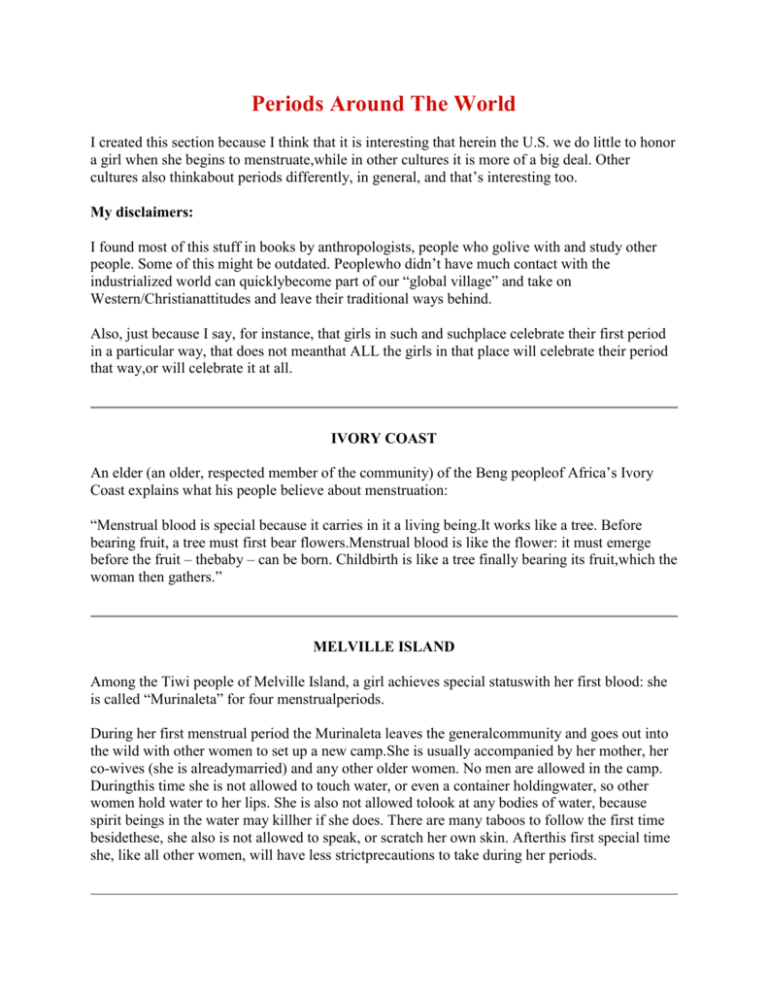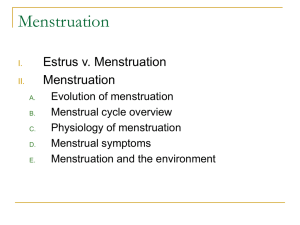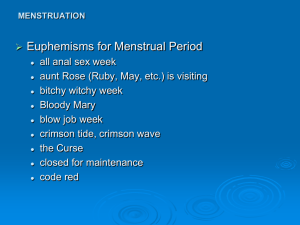Periods Around The World!
advertisement

Periods Around The World I created this section because I think that it is interesting that herein the U.S. we do little to honor a girl when she begins to menstruate,while in other cultures it is more of a big deal. Other cultures also thinkabout periods differently, in general, and that’s interesting too. My disclaimers: I found most of this stuff in books by anthropologists, people who golive with and study other people. Some of this might be outdated. Peoplewho didn’t have much contact with the industrialized world can quicklybecome part of our “global village” and take on Western/Christianattitudes and leave their traditional ways behind. Also, just because I say, for instance, that girls in such and suchplace celebrate their first period in a particular way, that does not meanthat ALL the girls in that place will celebrate their period that way,or will celebrate it at all. IVORY COAST An elder (an older, respected member of the community) of the Beng peopleof Africa’s Ivory Coast explains what his people believe about menstruation: “Menstrual blood is special because it carries in it a living being.It works like a tree. Before bearing fruit, a tree must first bear flowers.Menstrual blood is like the flower: it must emerge before the fruit – thebaby – can be born. Childbirth is like a tree finally bearing its fruit,which the woman then gathers.” MELVILLE ISLAND Among the Tiwi people of Melville Island, a girl achieves special statuswith her first blood: she is called “Murinaleta” for four menstrualperiods. During her first menstrual period the Murinaleta leaves the generalcommunity and goes out into the wild with other women to set up a new camp.She is usually accompanied by her mother, her co-wives (she is alreadymarried) and any other older women. No men are allowed in the camp. Duringthis time she is not allowed to touch water, or even a container holdingwater, so other women hold water to her lips. She is also not allowed tolook at any bodies of water, because spirit beings in the water may killher if she does. There are many taboos to follow the first time besidethese, she also is not allowed to speak, or scratch her own skin. Afterthis first special time she, like all other women, will have less strictprecautions to take during her periods. PORTUGAL Every winter in a small town in Portugal most households kill a pigand cure its meat for later use. Among the women who organize the butcheringsthere is a strict taboo against menstruating women helping to butcher apig or even entering a house where a pig is being cured. Whether or notthe woman intends it, her menstruation gives her the evil eye, and herpower is so great that she can ruin the meat by just looking at it. When a woman comes to the door, she is asked “Can you see?”and if she answers that she can, it means she is not menstruating. AUSTRALIA Aboriginal Australian men exercise ritual power through ceremonies inwhich they cut themselves to imitate women’s menstruation. In some tribesmen actually cut open their penises to reproduce the look of a bleedingvulva. They say that the women used to perform these ceremonies, that allof this ritual power really belongs to women (though their blood), butthat men have learned how to trick women: “But really we have been stealing what belongs to them (the women),for it is mostly all women’s business; and since it concerns them it belongsto them. Men have nothing to do really, except copulate, it belongs tothe women, All that belonging to those Wuwalak (legendary bleeding sisters),the baby, the blood, the yelling, their dancing, all that concerns thewomen; but every time we have to trick them. Women can’t see what men aredoing, although it really is their own business, but we can see their side…In the beginning we had nothing, because men had been doing nothing; wetook these things from women.” Aboriginal Australian women make a cat’s cradle design called “themenstrual blood of three women”. They usually make this design whenthere are only women around. If a man walks past he will not look at theirgame because it is part of the domain of women. Cat’s cradles such as thismay be used in their rituals for a girl’s first menstruation. NATIVE TRIBES OF NORTH AMERICA The Hopi The Hopi, like many other peoples, have myths about the magical powersof menstrual blood. “The Bloody Maiden Who Looks After Animals”is a mythological woman, who, legend has it, was angry at some Hopi hunters.She killed them, and then appeared before all of the people covered withblood. She grabbed a live antelope with one hand, and wiped her other handover her vulva. She wiped this hand on the antelope’s nose, and twistedits nose, and then let it free. She then told the people that from thenon it would be very hard for them to hunt the antelope. The Navaho The Navahos have a ceremony for menarche called Kinaaldá, whichcontinues today. It is considered the most important of their religiousrites. Its purpose is to make sex holy and fruitful. The menstruating girlis secluded and given instruction, and afterward there is a great celebrationin which the entire communtiy is involved. Girls may go through more thisceremony more than once during their first year of menstruation. The Yurok An anthropologist was visiting the home of a friend of his who was aa member of the Yurok tribe of Northern California On the way home, hisfriend explained to the anthropologist that his wife was having her period,and so would not be joining them for dinner. The anthropologist was surprisedthat his friend and his wife followed the old ways of isolating women duringtheir period. When they got to the house the wife appeared and explainedthat while she didn’t have a menstrual hut to go to, she often stayed inthe back room of their house during her period. Sometimes, though, shebecame restless and came out to talk, like tonight. The anthropologistasked her why she followed the old ways, and she explained that when shewas very young, she was raised in non-Indian foster homes, where she wastaught that menstruation was shameful, a punishment for women. When shereturned to Yurok society her aunts and her grandmother, who were verywell respected women, taught her differently, they trained her in the Yurokmenstrual rules. These rules say that when a woman is menstruating she is very powerful,and she should isolate herself at this time so that she should not wasteher energy on every day matters, or have her concentration broken by membersof the opposite sex. She learned that all of her energy should go toward meditating on thepurpose of her life, and the gathering of her spiritual energy. The menstrualshelter is the equivalent of the men’s sweathouse, a place where you goto look into yourself and make yourself stronger. They believe the flowof blood helps purify a woman’s body for spiritual tasks. During this time a woman must use a special scratching stick insteadof absentmindedly scratching herself with her fingers because she mustfocus her whole attention on her body by making her conscious of even themost natural actions. She be aware of her entire body all of the time. Through practicing the menstrual traditions women come to see that “theearth has her own moontime” and understanding that makes women strongerand proud of their own cycle. The Yurok woman also said that in the olddays all of the village women who were fertile had their periods at thesame time, so all of them would leave to go to the menstrual shelter atonce. The men of the village used that time to go and train in their owntraditions in their sweathouse. JAPAN This just a little observation: in Japan today tampons come with littleplastic finger coverings – like cut-off fingers of gloves – so that womendo not have to touch themselves “down there” when they put ina tampon. This might sound a bit paranoid, but tampons which come with applicatorslike the popular brands used by women in the United States seem strangeto European women whose tampons usually come without applicators. We haveapplicators so, like the Japanese women, we do not have to touch ourselves”down there.” NEW GUINEA Among the Arapesh people, who live in New Guinea, there is a traditionalcelebration of a girl’s first menstruation. It takes place in her husband’shome (Arapesh girls are married before they begin to menstruate), but herfamily takes part in it too. Her brothers build her a fine menstrual hut,a temporary home, where she sits with her legs crossed. Her woven arm andleg bands are removed, and the things she carries with her every day aretaken away, so that she will have a fresh start on life. She stays in the hut for three days, fasting. She drinks no water andeats no food. On the third day she comes out and an uncle makes littledecorative cuts on her shoulders and buttocks. This is called scarification,and is considered a beautiful way to decorate the body. INDIA In the South of India and in Ceylon, the Brahmin community performsa traditional ritual to celebrate the beginning of menstruation calledSamati Sadang. The hope is that the girl will lead a fertile life. Thegirl sits on banana leaves and eats raw egg flavored with ginger oil andthen she is given a bath in milk. When this ritual is over, the whole familycomes together to feast and celebrate her becoming a mature female. When a Nayar girl of India begins her period, she may be secluded, andthen visited by neighbor women and dressed in new clothes. She usuallywill begin wearing a sari, a woman’s dress, at this time. Later she andher friends will take a ceremonial bath, and then go to a feast where “drumsare beaten and shouts of joy are given.” TURKEY In a small village in Turkey, most of the villagers practiced Islam.The village women explained to a researcher that menstruation was givento women as punishment for Hawa’s (Eve’s) disobedience against Allah (God)in Cennet (Paradise). Her weakness, allowing Satan to tempt her to eatthe fruit, is a sign that all women are morally weak and need to be watchedover by men. Turkish women who follow Islam are not allowed to enter the mosque (temple),touch the Koran (sacred book) or join the community in fasting during thesacred holiday of Ramadan while they are menstruating. A menstruating woman also cannot join the Hajj, the pilgrimage to theholy city of Mecca. If she starts her period on the way, she cannot enterthe sacred part of the city. For this reason most women make the journeyafter menopause. KOREA In Korea a girl may be given a dinner in her honor when she has herfirst period. One of the traditional dishes for this occassion is a specialsoup made out of seaweed. ANCIENT IRELAND In an ancient Celtic story called “The Cattle Raid of Cuchalainn”there was a beautiful, powerful warrior queen named Maeve. She led herpeople in battle against the legendary hero Cuchulainn. According to the story, Queen Maeve was an equal opponent for this greathero. The only reason she lost the battle against him is because her periodbegan and she had to get out of her chariot to take care of it. When shedid, Cuchalainn snuck up behind Queen Maeve and captured her. The spoton which she bled was forever after known as “Maeve’s Foul Place.” UGANDA In Uganda when a girl has her first period she might get to stay homefrom school. Her mother and her aunts would then spend the day with herand tell her things she needs to know. Later, her girl friends would come to visit her and have a party. They’dall sing a beautiful song about menstruation together to celebrate.











